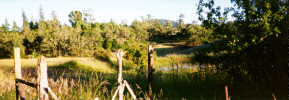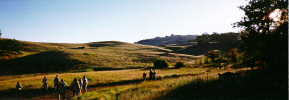By Claude

Over the 1996 summer solstice, one hundred members of the Hearth
community, gathering from such divers locales as New York, New Mexico,
Micronesia, Mexico, and the West, celebrated their 25th year of
stewardship, and the 29th year of liberation, of "the land."
Fifty acres located in the saddle between Poonkinney and Imtomel,
northwest of Covelo, California, the land is yet another branch of the
Digger tree rooted in the Haight, 1967.
Visions of urban apocalypse emerged out of my experiences in San
Francisco, and by July 1967, I had placed an order with the Cosmic
Redistribution Service for rural land that would be refuge and a place
where survival skills could be learned and taught. Bill Love (Loughborough)
and Alan Myerson, of the Committee Theatre, introduced me to Bill Buck
(William Benson Buck III), who quickly grasped the concept and offered
money to help. By October 1967 H'Lane and I had found and bought the land,
an army truck, and some other equipment. Bill Buck's generosity amounted
to some $11,000.
By March 1968 we were residing on the land, maintaining contact with
Digger and Free Family folks in San Francisco and Marin. We felt we were a
sister to the Black Bear community, although in the first three years we
had a very low population.
In 1971 H'Lane and I decided to move with our children, Clane and Haud,
to New Mexico, where I still live. Having defined the land as having been
"removed from commerce," we sought out a new steward for the
land. I believe it was at the Briceland truck stop that we encountered the
parents and kids of Hearthshire School on an outing in someone's WWII
"duck" vehicle. We offered to give them the land if they would
accept solemn stewardship over it and honor its original vision. In April
1971 they accepted.
<><><>
To make a long story short, Hearthshire (now the Hearth School, a
legally constituted California educational nonprofit) had a long history
of social/educational experiments, and raised a fine crop of kids,
occupying the land up until about 10 years ago. At that point, consensus
was reached that de-occupation and restoration were necessary. Everything
- the detritus of 19 years of anarchic occupancy - was cleaned up, and no
one lived there until recently, when Glen Bear (aged 85) moved up, erected
a tipi, and took up residency for his final years. He had last lived there
in 1972, and still feels it is the most beautiful land he has ever seen.
He is, I believe, helping the land by clearing up some of the accumulated
dead and down fuelwood that threatens the old growth douglas firs and
ponderosas. Stewardship continues.
As "steward emeritus," I have periodically visited the land
and with members of its community to nourish the legend of the Digger
legacy. I commend the Hearth community for their dedication to the
founding vision, and am now partaking with them in a process of evolving
our vision to reflect certain realities of the mid-'90's, and our own
increasing awareness of the land's needs. We are also defending the
original boundary of the land, which is presently being wrongfully
contested by a rancher neighbor who ought to know better.
This is just a sketch in a long and intense history of activity on this
land. A.L. Kroeber knew of this ridge and mentions it (in "The
Handbook of the California Indians") as the boundary between the
acorn/basket weaver cultures and the river valley/salmon fisher folk
cultures; in fact, a boundary between two major language groups. They met
there to fight or trade. Artifacts of these peoples have been found there,
and their descendants live nearby.
Keep the faith.
Claude Hayward
[At the moment, I'm not online. Reach out to me at HCR 67, Box 5, Anton
Chico, NM 87711; (505)427-4202.] |
By Jasmine

My experience with Hearthshire School started in August 1968 at a
sign-up booth at a fair in Precita Park in San Francisco. Evidently the
Shire School, the original "free school" in San Francisco, had a
full enrollment, and so the spillover, led by Michael Shire, Pam Gogulski,
and Paula and Al Martinet (who dropped out when he became politically
involved with the Brown Power movement), made use of incorporation papers
from "The Hearth" (a community preschool located in a church
basement in the Haight) to form a new free school. Some of the Hearth
students and parents also made the transition to Hearthshire. We amended
the papers to include children up to age eighteen and, later, people of
all religions and sexual preferences.
Hearthshire School was free in every sense. There was no tuition, and
we had no mandatory classes. The teachers donated their time and
materials, and money for expenses such as rent was also donated. Many of
the teachers were parents, but there were also some altruistic people who
had no children and worked for the love of it. We had a number of school
sites, beginning in downtown San Francisco on Bryant Street, and in the
Mission district, first at 16th and Bryant Streets, and later at an old
building with a vacant lot that eventually became the home of Kaliflower.
Some of the families were nuclear, but many of us lived communally, at
houses variously located at Church Street, Valencia Street, Capp Street,
and Laidley Street.
The school was very big on field trips. We would go on day trips to
Muir Beach to gather mussels, or to Mt. Diablo. Some field trips were more
political, as some teachers took interested students to the riots at San
Francisco State or People's Park. We also went on a two-week camping trip
to the Mendocino National Forest, and to Big Sur.
More and more we felt we wanted our children to run free, away from the
confinements of the city. One of our community inherited money and donated
it to the school to buy land. In the spring of 1971 we headed up toward
Humboldt County, and ran into Claude and H'Lane Hayward at the Briceland
garage. They had property near Covelo that they were willing to give to us
as long as we maintained it as open land. We agreed, and the papers were
quickly transferred.
In May 1971, I arrived at the land with my six-month old baby and my
two older children, along with a group of Hearthshire parents and teachers
and many children (some of whose parents remained in the city), and a
group from the Oakland Free Bakery who had come by way of Black Bear. Some
other members of the community were already there, having made the trek
from Briceland to Covelo by horseback over the mountains.
At the time we arrived, the only existing structure on the land was an
A-frame barn. That summer Claude joined us for a short time and organized
a mammoth barn raising that used pure people power to greatly enlarge the
barn's capacity. There were a few individual cabins built, but the barn
became the community center where most of us ate and slept and partied
during cold weather. During the summer, most activity took place just
outside the barn under some huge old fir trees, our outdoor kitchen.
Because we parents and teachers were so busy building, putting in
sanitation systems, and feeding everybody, there was little in the way of
formal classes. The children tended to run in packs. More and more single
young people began to show up.
When winter finally came, many of the children whose families had
stayed in the city returned there. The first winter there were upwards of
20 people living in the barn, and we had over 60 people, drumming and
feasting, to celebrate our first Thanksgiving. Still, many found that
first winter too hard (we were snowed in most of that time), and the
situation just too primitive with no electricity or running water. By the
second winter, the majority of families had left.
Over the next few years came a series of new people, mostly single,
intrigued by the challenge of living on the land. These were widely
diverse, including gay men and women, Vietnam vets, teenaged runaways.
Most stayed only a short time, but nobody forgot the experience.
I myself left the land in 1978 to move down into Round Valley, fifteen
miles away, after my two older children had left to go to public school
and my younger son began making demands to do the same.
A few years later an offshoot of Hearthshire School sprang up in Round
Valley, and lasted for about five or six years. Some children who attended
were born at the land or their parents had lived there, so there was a
close connection.
Today there is only one person living on the land, Glenwood Bear, who
had lived there during its heyday and who has returned to live his last
years there.
The land has seen a lot. Children have been born and others conceived
there. There has been a death by suicide and a shooting incident. There
have been many gardens, many feasts, much music. Our community is now
spread over the world, but it is still close knit. We gather every year at
summer solstice to have our annual meeting and party. We also have
workshops where young people from the Hearthshire (now Hearth) community
and the local community come to learn crafts, to create ceremonies, to
experiment with wilderness skills.
This year we celebrated the 25th anniversary of Hearthshire on the
land. The beautiful, open, and loving young people who came are living
proof of the ideals of our community.
Long live the land!
Jasmine Parker
neé Frances Parker
Goat Berry Sky
|

